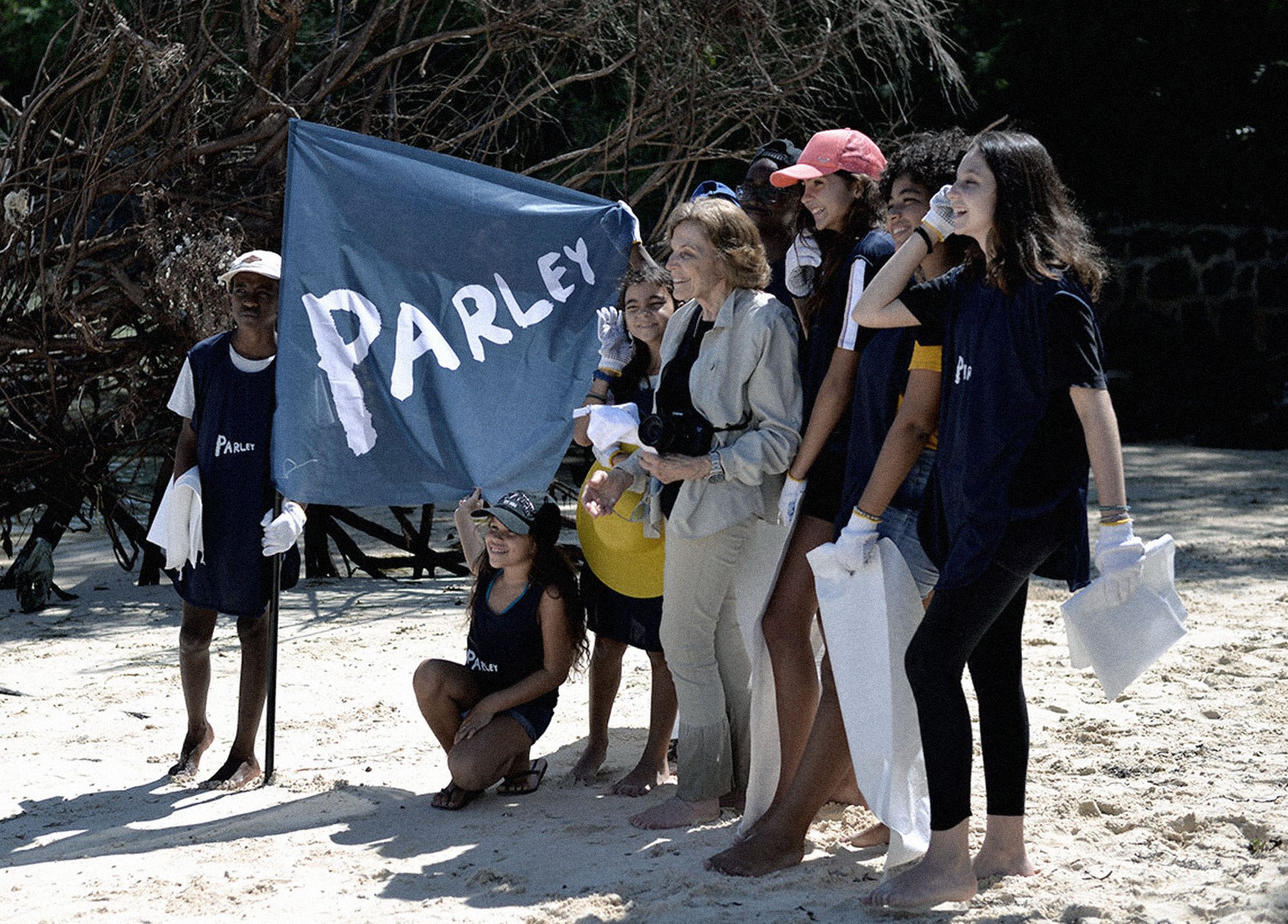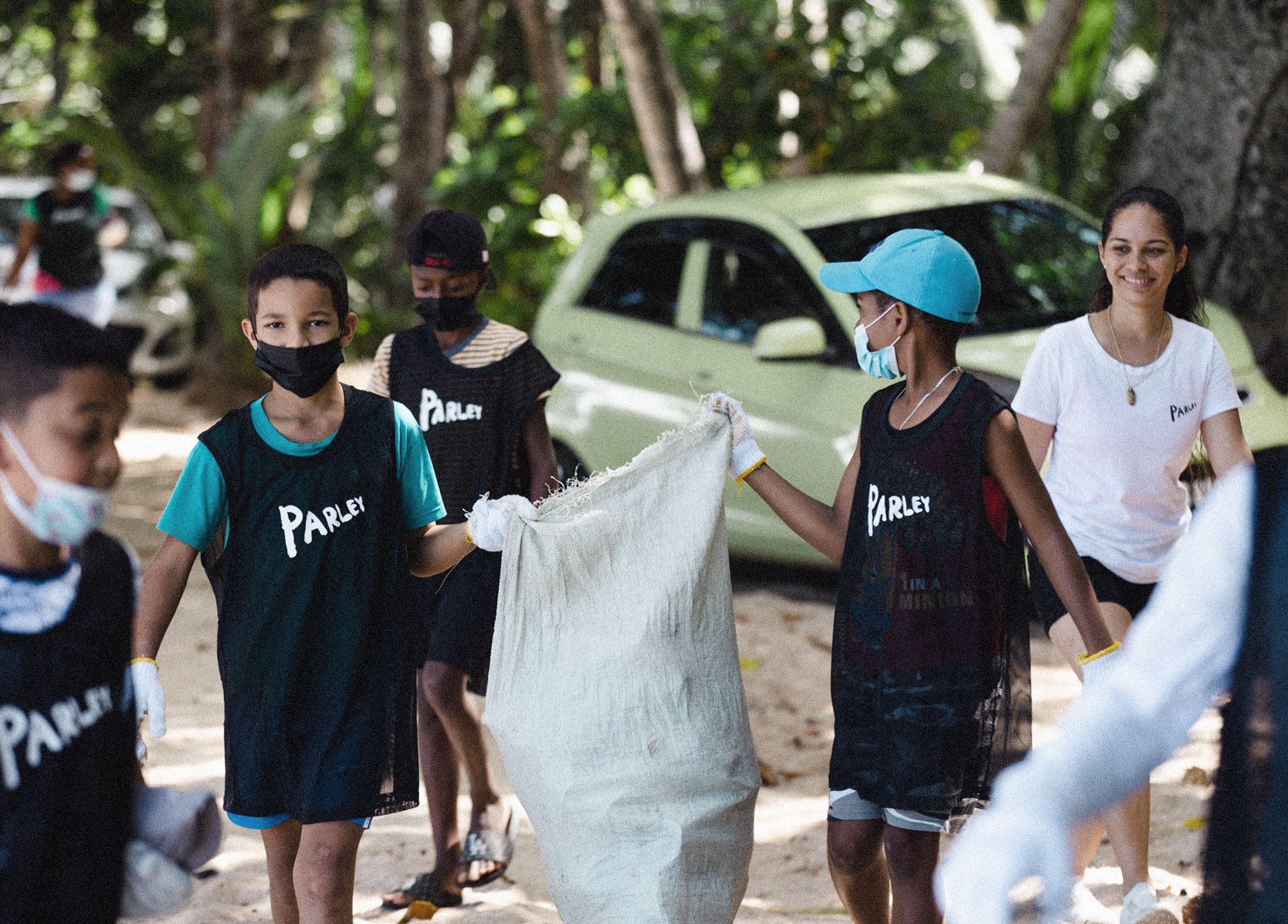PEOPLE: ALVANIA & JESSICA LAWEN
WE CATCH UP WITH THE LAWEN SISTERS FROM SEYCHELLES TO CHAT GIANT TORTOISES, PLASTIC BAG BANS AND WHY THOSE CHOSE THE ISLAND OF LA DIGUE FOR CLEAN WAVES
Once thought to hold the Garden of Eden and even mythical underwater coconut trees, the Seychelles have long been considered a natural paradise. A nation of 115 islands lying a couple of thousand miles off the coast of Africa in the Indian Ocean, once home to giant tortoises and flightless birds crucial to our understanding of evolution, is now home to a population of 100,000 humans, including three of Parley’s favorite people on the planet: the Lawen sisters.
For when Alvania and her twin sister Nathalia were just 13 years old, they successfully led a campaign to ban single-use plastic bags across the archipelago, from the capital Mahé to smaller islands such as La Digue — where the proceeds from the sale of Clean Waves’ Archetype range goes towards protecting two beautiful, boulder-strewn white sand beaches from the scourge of plastic pollution — which led her to speak on behalf of her country at the United Nations General Assembly in New York.
Alvania & Nathalia
Not long after her star turn at the UN Oceans Conference, Alvania joined forces with Parley to become our country coordinator for the Seychelles, working locally to champion the AIR Strategy across the country and even hosting legendary oceanographer Dr Sylvia Earle and the BBC at clean ups across the island — all this before graduating high school.
Not yet out of her teens, Alvania is now studying Environmental Management and Sustainability on another island—Britain—yet still coordinates Parley’s Seychelles program from afar by working in close collaboration with her older sister, Jessica, and even spent her summer holidays training government represents and volunteers in Andhara Pradesh for Parley India’s massive beach clean up in the Bay of Bengal. For as she explains in this interview with Jessica, no one on this vast blue planet we call home is an island, as in the ocean of life all is connected.
“La Digue is a very close-knit community with a real island vibe, everyone gets around on bicycles there, and everyone knows each other, the tortoises included!”
WHAT WAS IT LIKE TO GROW UP IN THE SEYCHELLES?
Alvania: We grew up in Victoria, the capital of the Seychelles, but our mother has family in La Digue, the neighboring island, so we would sometimes go there to meet up with our cousins, and we would usually play about in a fiberglass boat, and with the coco de mer that washes up on the beaches. Other times we would go to Sunday service at the church right next to the school. There were horses back then on La Digue, and also cows used to make the coconut oil on the island.
Jessica: La Digue is also famous for its tortoises — they will stop ‘traffic’ if they’re crossing the road. People will just sit there and wait for them to go by. All the tortoises have names and people love them. It’s a very close-knit community with a real island vibe, everyone gets around on bicycles there, and everyone knows each other, the tortoises included!
HOW DID YOU GET INVOLVED IN THE CAMPAIGN TO BAN PLASTIC BAGS IN THE SEYCHELLES?
Alvania: When my twin sister Nathalia and I were about 13 years old, we were volunteering with an NGO called SYAH-Seychelles, which launched the SEY No To Plastic campaign, and we would go out and do beach cleanups. I saw so much plastic in a country where we’re known for our beautiful beaches and ocean — it was really horrible to see and it made me really understand why we needed to ban plastic bags. SYAH also worked in collaboration with another NGO called S4S, and they made gunny bags, which are like tote bags made from jute, but instead of being brown, they were blue and printed on the side was the message ‘SEY No To Plastic Bags’. We would take these bags everywhere we went, post photos up on Facebook and Instagram, and Nathalia and I appeared in an advert shown on TV and Facebook raising awareness about the need to avoid using plastic. This led to us having seminars and meetings between the NGOs and the Ministry of Environment, and as a team we managed to convince them to ban plastic bags from the Seychelles.
Alvania & Jessica
SO YOU AND NATHALIA WERE THE FACES OF THE CAMPAIGN?
Alvania: I think so, yes. Sometimes we would be walking around and people would come up to us and say stuff like, "Oh, you’re the reason we can't use plastics anymore!" They would joke about it.
JESSICA, WERE YOU INVOLVED AS WELL?
Jessica: No, I was not involved. Growing up, it was always Alvania and Natalia who were most involved in activism and the fight against plastic. I was always the supportive older sister.
SO WHAT CHANGED?
Jessica: When Alvania went to university in England in 2021, Parley was looking for a new country coordinator, so I applied and went through a bunch of interviews, and they were very happy to know that I'm Alvania's sister! So when I finally got the job, Alvania and I have been working together ever since.
Alvania: What Jessica maybe doesn't realize is that she was my inspiration for environment, because when she was around 13 she was in the heritage club at high school, and she would go to all these hikes and beach cleanups and activities relating to the environment. It was her activism, hard work and dedication that encouraged me to find my own passion.
OH, THAT'S BEAUTIFUL. TELL US MORE ABOUT YOUR WORK WITH PARLEY IN THE SEYCHELLES.
Jessica: I think we're one of the Parley teams in the Global Network that holds the most beach clean ups. We usually do at least two cleanups a month, and then we have educational talks in schools, but we haven’t had a school talk for a couple of weeks as the landfill in Mahé caught fire, and all the schools in the central areas of Victoria had to close because of the smoke. There is also a landfill on La Digue, but it’s much smaller — our main waste management structure in the Seychelles are landfills, and there’s only one recycling center, which recycles glass, cans and plastic, but only PET plastic, so there’s a lot of room for improvement.
“We need to step out of that out of sight, out of mind mentality when it comes to the trash we are creating and educate ourselves about where it ends up. ”
WHY DID YOU CHOOSE LA DIGUE FOR CLEAN WAVES?
Alvania: Earlier in the year we did a lot of scouting around the Seychelles for Clean Waves, and La Digue was a really exciting trip. We went up to the mountains, to the nature reserve where you can see the Paradise Flycatchers, and along the whole coastline. Most people live by the coast, and the beaches are very white and pristine, not at all developed like on Mahé. We got to meet the member of parliament for La Digue, and they were really happy to have us and very supportive of the project — they really want to engage with the Parley AIR strategy. I think on the whole, people in La Digue have a stronger connection with the ocean than people on Mahé. They understand the need for its protection, even before hearing it from researchers and scientists; they see it firsthand, so they understand the challenges and they figure out the solutions.
Jessica: The Seychelles is an archipelago of more than 115 islands, and only four of these islands are inhabited by the public, the rest are either conservation sites or they’re hotels. But in the Seychelles, all beaches, even if an island is ‘private’ are public and they belong to the people — it’s just that some of them are very difficult to get to. About 5,000 people live on La Digue, making it the third most populous island in the country, and, also very accessible. There are ferries going to and from the main island every day in the morning and the evening. Seychellois go there all the time, and of course tourists — for many years La Digue had ‘the most beautiful beach in the world’, Anse Source D'Argent, though we think it’s dropped a couple of places on the list recently. So, we think it's a perfect place for Clean Waves because it’s so accessible people will directly see the impact.
AND WHY THE BEACHES OF GRANDE AND PETIT ANSE IN PARTICULAR?
Alvania: They are the two longest stretches of beach on La Digue. They're far from the main town, about 30 minutes away on a bicycle, and as they face the Indian Ocean, they are the most polluted as well. It’s very rare to see microplastics in the Seychelles, but a lot of plastic just floating across the ocean gets broken down in the gyres and washes up there.
Jessica: There is also a lot of trash from the fishing industry. It can be in the form of Styrofoam, which some, though not most, local fishermen usually put their catch in, but quite often it’s discarded fishing gear, like nets and lines, from larger fishing vessels from the EU.
WHAT KEEPS YOU MOTIVATED?
Alvania: For me, it is 100 percent my passion. I just feel it with my heart. I don't blame normal people like us for the plastic problem — I blame industries and manufacturers. But coming from an island nation, I feel like it's my responsibility and my duty. The ocean doesn't have any boundaries, and when I was helping organize the clean ups in India, I even identified a few plastics that we find in Seychelles. And that's horrible to see. My heart is for my country, and also for islands because they're so vulnerable. Plastic is just swirling around in the gyres and at some point, they have to deposit in islands because we're small masses of land in this vast ocean.
Jessica: My ultimate drive comes from having a little boy, because it's evident that the beaches we're seeing today, the trees we're seeing today, they're not the same as they used to be when we were growing up. It used to be so much greener, so much cleaner. Now you can't set foot on a beach without seeing a plastic bag or a stray slipper or a picnic that has been left behind. So, for me, it's ultimately my son because I'd like for him to have, and for his children to have, at least a little bit of what we had growing up.
Photography by Dario Didon












